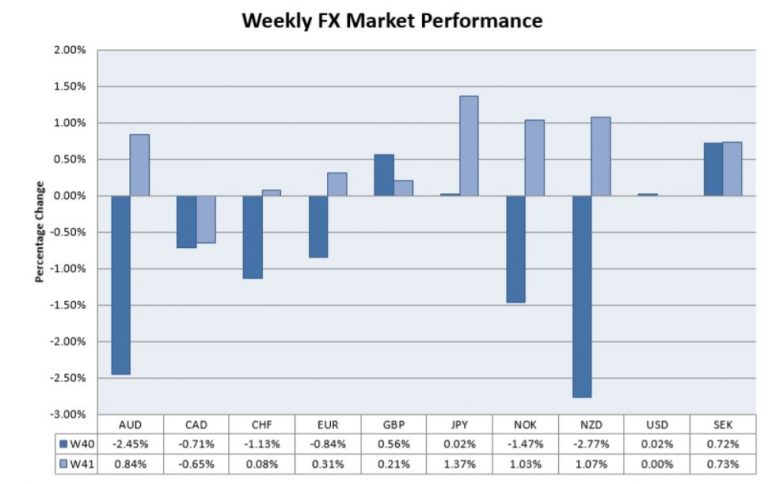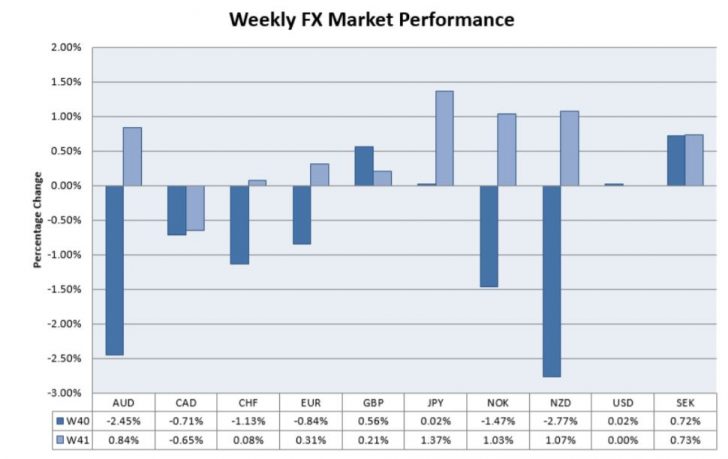Categories
Weekly Currency Market Performance and Highlights
What were the important economic events and market trends of the past week?


Notice
This Post has ended its release period. Please check Orbex's latest information and campaign on Orbex's company introduction page.
Orbex - What's now?
We are no longer promoting Orbex. The information regarding to Orbex on the website '' maybe outdated. ref. Orbex
The USD was the second weakest currency last week, giving way for most of the other currencies to post strong gains over last week.
The JPY emerged on the top as the best performing currency over the week. The JPY gained 1.37% on the week as the currency gathered from the previous week’s modest rebound of 0.02%.
The CAD was the weakest performing currency. The currency fell 0.65% on the week.
The EUR also managed to post some strong gains last week. The currency closed 0.31% higher on the week. This comes after the euro currency fell 0.84% in the week before. The weakness in the USD managed to push the euro slightly higher on the week.
The GBP failed to capitalize on the strong declines in the USD last week. The currency rose just 0.21% on the week. However, this marks a second week of gains with the currency extending the gains from 0.56% in the previous week.
The NOK managed to post strong gains on the week. The currency rose over 1.0% in the week 41. This potentially reversed some of the declines of 1.47% posted in the week before.
The SEK currency maintained the same pace of gains as the week before, advancing 0.73% on the week.
The AUD and the NZD currency pairs managed to post a rebound after a prolonged bout of declines. The AUD rose 0.84% reversing some of the losses from the week before. The NZD currency rose 1.07% on the week, reversing part of the declines from the week before.
Market Highlights of the last week
US Consumer prices
Consumer prices in the United States eased during the month of September, data from the U.S. Labor department showed last week.
Despite the decline, the overall inflationary pressures are seen to remain robust.
Official data released last week showed that the U.S. inflation rate increased just 0.1% on the month.
This was below the median estimates of a 0.2% increase.
On a yearly basis, headline inflation advanced 2.2% in September.
This was a slower pace of increase compared to the 2.7% increase seen in the year ending August.
Core CPI which strips the volatile food and energy prices increased 0.2% matching estimates.
Core CPI on the year is also at 2.2% for September.
UK GDP Report
The UK’s monthly GDP report was released week. Data showed that on a month over month basis, GDP remained flat.
However during the three months ending August, the UK’s gross domestic product advanced 0.7%.
The increase in activity was seen coming due to a warmer than expected weather which helped growth.
The manufacturing, industrial and construction output reports were also released last week.
Data showed that manufacturing production fell 0.2% in September.
Construction output posted a strong decline of 0.7% while industrial production managed to rise 0.2% beating estimates.
The mixed numbers indicate that the UK’s economy was still not out of the woods.
IMF Economic Forecasts
The IMF released its semi-annual economic forecasts last week.
According to the forecasts, the International Monetary Fund was seen slightly lowering its growth forecasts for 2018 and 2019.
The GDP growth forecasts for the United States, the Eurozone, Japan and Britain were also lowered.
The IMF cited that the risks of the current global trade policies would potentially prove to be a drag on the global economy.
The institution noted that growth in the United States came on the back of the fiscal stimulus program launched by the Trump administration.
However, the IMF expects that the effects of this could potentially fade into the fourth quarter of the year.
German GDP
Germany cut its economic growth forecasts last week.
For the year 2018 and 2019, the German GDP growth is expected to average around 1.8% and 1.9% respectively.
This was a downward revised GDP forecast.
Officials cited the fallout of the trade disputes between the United States and China.
There was also a shortage of skilled workers adding to its woes. Germany is the Eurozone’s leading exporter.
GDP growth is expected to be fuelled by strong domestic demand. However, forward looking indicates suggest weak sentiment due to the trade uncertainty.
UK Equity Markets
The markets turned volatile last week, lead by a panic sell off in the U.S. equity markets as the U.S. treasury yields continued to soar.
This quickly spread to the Asian and the European markets by Thursday morning last week.
Investors expect the Federal Reserve could likely hike rates at a faster pace than it has initially projected.












